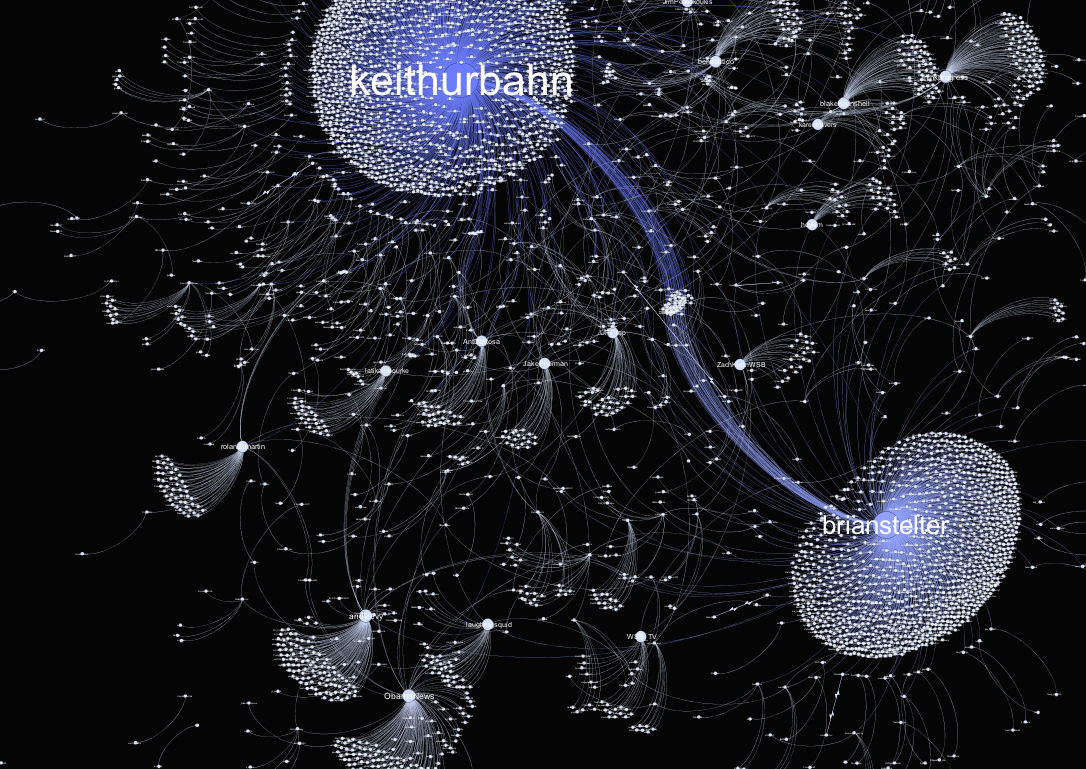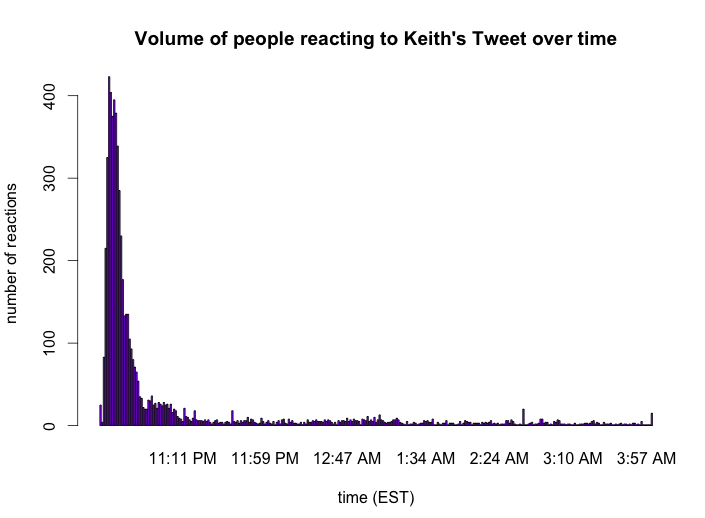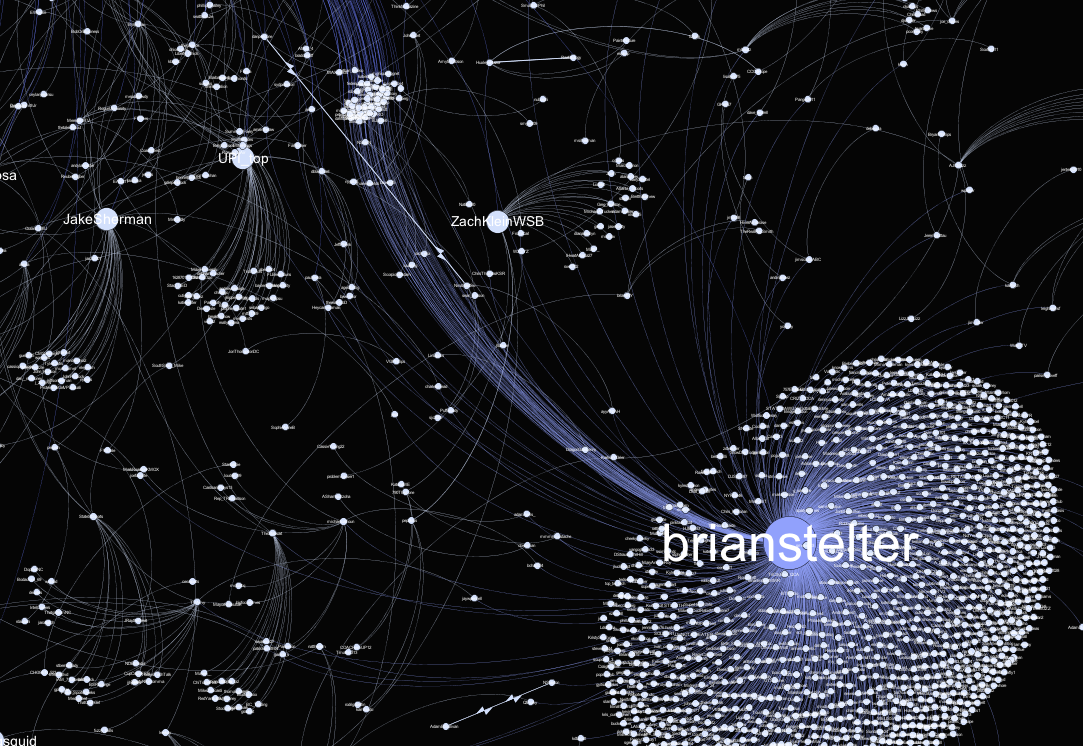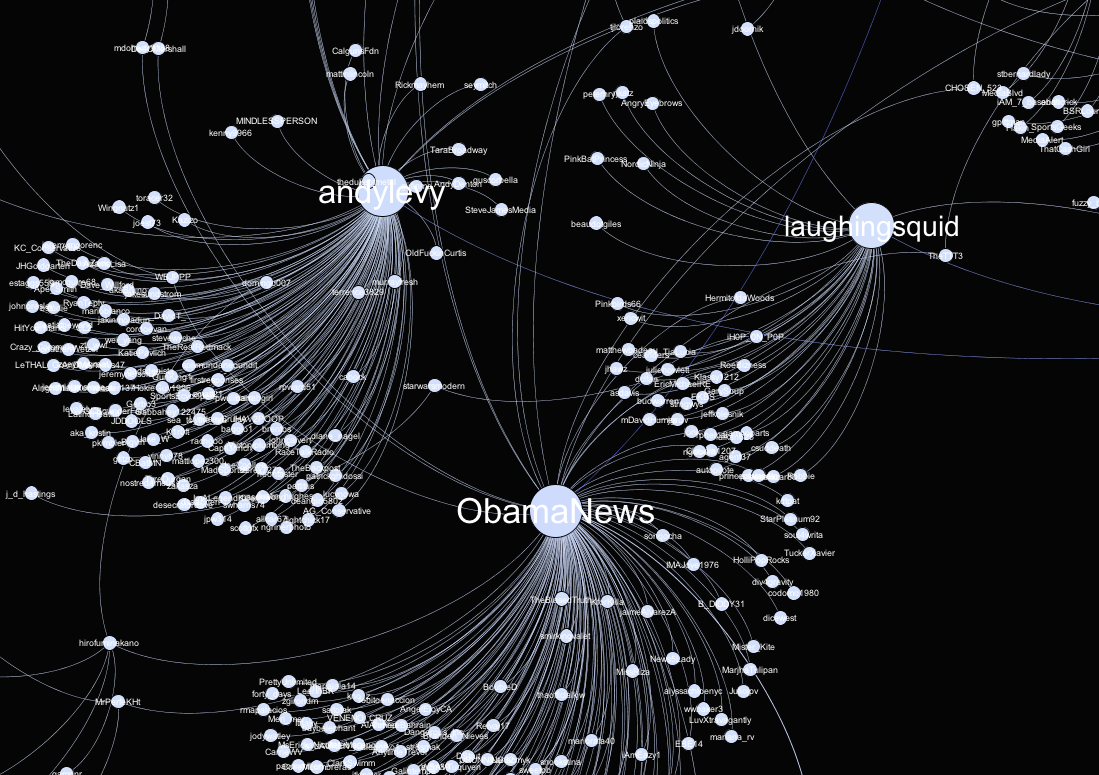

|





|
|
Syndicated Articles
Articles originally published on another site. |
|
by: Farrah Brooklyn Museum: Community: bloggers@brooklynmuseum � Brooklyn Museum API: Collections iPad App 28 views COMMENT(S) |
|
by: SocialFlow A full hour before the formal announcement of Bin-Laden’s death, Keith Urbahn posted his speculation on the emergency presidential address. Little did he know that this Tweet would trigger an avalanche of reactions, Retweets and conversations that would beat mainstream media as well as the White House announcement. Keith Urbahn wasn’t the first to speculate Bin Laden’s death, but he was the one who gained the most trust from the network. Why did this happen? Before May 1st, not even the smartest of machine learning algorithms could*have predicted Keith Urbahn’s online relevancy score, or his potential to spark an incredibly viral information flow. While politicos “in the know” certainly knew him or of him, his previous interactions and size and nature of his social graph did little to reflect his potential to generate thousands of people’s willingness to trust within a matter of minutes. While connections, authority, trust and persuasiveness play a key role in influencing others, they are only part of a complex set of dynamics that affect people’s perception of a person, a piece of information or a product. Timing, initiating a network effect at the right time, and frankly, a dash of pure luck matter equally. At SocialFlow we’ve analyzed the effects of timing and topicality within social streams. In this study we looked at 14.8 million tweets and bitly links with the goal of reaching an understanding on how timing, along with other core dynamics can amplify the reach of a single tweet to a massive scale. Below is a visualization of the network graph showing the spread of Keith Urbahn’s single speculative tweet across users on Twitter.  The shape of rumors on Twitter On the evening of May 1st, people using Twitter figured out that Osama Bin-Laden had been killed over an hour before the formal White House announcement. Within minutes of hearing about the emergency presidential address, Twitter users were actively working to figure out the puzzle. 38 minutes after the announcement about Obama’s address, a certain tweet confirming speculations posted by @keithurbahn, Chief of Staff at the office of Donald Rumsfeld, started spreading like wildfire. Keith was not first to speculate that the address is related to Bin-Laden, nor did he have a particularly influential presence on Twitter, with a following of 1,016 and a casual digital portrayal. But the right network effects came into play, and enabled his post to generate enough trust amongst his followers, their followers, and so on. * At SocialFlow we analyzed 14.8 million public Tweets, and bitly links, posted between news about an unplanned presidential address (9:46 p.m. EST) and Obama’s address (11:30 p.m. EST) to see how dynamics of rumor creation played out during those critical hours on Twitter. Out of the dominant information flows observed in the data, we focus on the largest flow, engaging tens of thousands of users, validating speculation around Bin Laden’s death.* Who knew what and when? * Twitter has proven time and time again its value in tracking events as they unfold in realtime, accelerating the flow and spread of information across the globe. Twitter has become the dominant mechanism to get timely updates about events that are taking place regardless of geography, topic or even language. However these same network properties that make Twitter so effective for accelerating information flows, can just as easily lead to misinformation spread. Rumors about OBL’s death leaked out to Twitter, before hitting TV, and certainly before the formal presidential address. But how and where did they start? And how did they solidify from being merely speculative, to common belief? * News about the presidential address reached Twitter as early as 9:46 p.m. EST, prompting curious Twitter users to make guesses about the nature of the unplanned address. Many guessed that the breaking news has to do with Gaddafi, whose son was killed a couple days beforehand. Others passed jokes, such as the following by a user named @pandagon: “Obama to address nation at 10:30 to announce that Bill Ayers is his real father.” * And then there were those who were barking up the right tree. * @commentkazi wrote: “I’m guessing we got Bin Laden”. Twitter’s brevity and social nature enables people to easily attach their opinions to information that they’re passing. A user by the name of @kerrioki reacted to a Reuters announcement by retweeting it, and attaching a personal speculation: “RT @Reuters: FLASH: President Obama to make statement shortly: White House *|| What can it be? Gaddafi? Bin Laden? Trump?”. * By publicly engaging with each other on Twitter, users could jointly build out and break hypotheses, piecing together all known facts, until what’s believed to be a believable “truth” emerges. Many people were trying to figure out the puzzle together. For example, a snippet of conversation between Matt Mackowiak, GOP consultant, and Jonathan Capehart of the Washington Post and MSNBC: * @MattMackowiak: 10:30pm ET statement is not intended to impact newspapers, it’s too late — intended to impact markets Monday, I suspect @CapehartJ: Whatever it is, it couldn’t wait until tomorrow a.m.* Michael Cohen, a Senior Fellow at the American Security Project and and Elmira Bayrasli, a Forbes blogger had the following conversation: @speechboy71: Seriously, anyone have any idea why Obama is speaking at 10:30? Anyone?Public conversations on Twitter engage and prompt others to participate, debate and jointly form opinions. Michael’s conversation with Elmira, sparked a reaction from @michaelbd, a NY based reporter: @michaelbd: @speechboy71 or ground troops in Libya?Michael Cohen (a.k.a @speechboy71) got it right. He was one of the first people to speculate correctly. However, his message was not seen by many, nor was it reposted by his followers. We can’t say exactly how many of Michael’s followers saw his message, but whats clear is that it did not spark reactions. But even though Michael’s online engagement levels were higher and he was one of the first people who reached the right speculation, he was (1) not convincing enough in his tone, and (2) did not engage his followers to respond and support his hypothesis. The tweet that trumped At 10:24 p.m. EST, Keith Urbahn posted the following Tweet, stating that a source he trusts claims Osama Bin Laden was killed:  The rate at which Keith’s message spread was staggering. Within a minute, more than 80 people had already reposted the message, including the NYTimes reporter Brian Stelter. Within two minutes, over 300 reactions to the original post were spreading through the network. These numbers represent the people who either retweeted Keith’s original message, or posted a reaction to it. The actual number of impressions (people who saw Keith’s message in their stream but didn’t repost it) is substantially higher.  Below are some examples of reactions and retweets from users passing Keith’s message onwards: @JakeSherman: Rumsfeld chief, @keithurbahn, says he’s told bin laden is dead. (10:24 p.m. EST)The following logarithmic figure is a minute-to-minute detailed comparison of the frequency of appearance of Bin Laden vs. Gaddafi related tweets during the three hour window. Before the announcement about an emergency presidential address, the terms were equally used on the network. However, as speculation about a connection to Bin Laden strengthened, we see a clear rise in people’s discussions and reposting of content about OBL. This spike occurs at just about the same time that Keith posted his valuable piece of information:  The network graphs below illustrate Twitter users who were critical in spreading Keith’s post onto their networks. Brian Stelter, who has over 50k followers on Twitter, engaged his audience and yielded hundreds of retweets, furthering the spread of this message:  By zooming into a section of the image, we see how twitter accounts such as @andylevy, @ObamaNews and @laughingsquid engaged their followers to retweet and react, playing an active role in passing the information onwards:  Influence, trust and attention Authority, trust and persuasiveness play an important role in influencing others, but are only part of a complex set of dynamics that affect people’s perception. Connections are another important factor, along with timing and a dash of pure luck. But as humans, we are still incredibly irrational, and constantly make decisions based on our intuition, or whatever we feel like at that moment.* As we build out digital social spaces, we must not get derailed by metrics of status affordances that have taken center stage. Just because we have easily accessible data at our fingertips doesn’t mean that we have the capacity to model and place a value tag on human behavior. Followers, friends or likes represent an aspect of our digital status, but are only a partial representation of our general propensity to be influential. Keith Urbahn wasn’t the first to speculate Bin Laden’s death, but he was the one who gained the most trust from the network. And with that, the perfect situation unfolded, where timing, the right social-professional networked audience, along with a critically relevant piece of information led to an explosion of public affirmation of his trustworthiness. Gilad & Devin For questions, thoughts or comments get in touch with the SocialFlow Research & Development team:*@gilgul | @dgaff*| @cherplunk More... 104 views COMMENT(S) |
|
by: Farrah TA3BEER: Meditations on Mediation: The Revolution Will Be Put on Trial … Via Social Media 32 views COMMENT(S) |
|
by: Farrah An Egyptian online activist's rationale for how twitter helped facilitate the Egyptian Revolution: #Jan25: One Tweet, One Story � Hope140 Blog 26 views COMMENT(S) |
|
by: Farrah If you witnessed and recorded it now tag it and participate in making this collaborative documentary. "We want to tell the story of the Egyptian revolution with the same tools that helped share it with the world in realtime. We want #18DaysInEgypt to be a crowd-sourced interactive documentary of the events in Egypt from #Jan25 to #Feb11." #18DaysInEgypt 34 views COMMENT(S) |
|
by: Farrah Middle East - The Christian Science Monitor - CSMonitor.com 23 views COMMENT(S) |
|
by: Farrah This is the Democracy Now! transcript that I helped transcribe for Feb. 11, 2011 live coverage from Cairo. The Egyptian Revolution: A Democracy Now! Special on Mubarak's Resignation 21 views COMMENT(S) |
|
by: Farrah Middle East Revolt: Youth, Technology Are Driving Change - TIME 18 views COMMENT(S) |
|
by: Farrah https://www.nytimes.com/2011/01/23/wo...unis.html?_r=2 13 views COMMENT(S) |
|
by: Farrah Anonymous Internet Users Team Up To Provide Communication Tools For Egyptian People 14 views COMMENT(S) |
|
by: Farrah How Wael Ghonim Sparked Egypt's Uprising - Newsweek 15 views COMMENT(S) |
|
by: Farrah https://www.nytimes.com/2011/02/16/te..._r=3&ref=world 14 views COMMENT(S) |
|
by: Farrah https://www.nytimes.com/2011/02/01/wo...i.html?_r=1&hp 10 views COMMENT(S) |
|
by: Farrah BBC News - Tunisia protests against Ben Ali left 200 dead, says UN 11 views COMMENT(S) |
|
by: Farrah Twisting Assad's Arm - By Andrew J. Tabler | Foreign Policy 10 views COMMENT(S) |
| LINK TO R-SHIEF Either link directly to it using the HTML code below or right-click one of the images below and select "Save Image As."   |